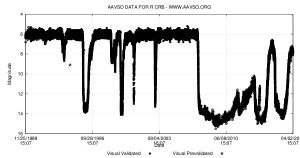Today’s seminar: R Coronae Borealis stars

Today Geoff Clayton from Louisiana State University gave a talk about R Coronae Borealis stars at our astrophysics seminar. These kinds of stars show erratic drops of several magnitudes in brightness over hundreds of years (R Coronae Borealis itself was discovered to be variable in 1795), and it’s still a somewhat open question what these things actually *are*. It’s not at all my field of study, but it was a really interesting talk and exactly the kind of talk I hope to see when I go to our seminar series. The talk had some whimsical bits and pieces about the discovery history, introduced the main hypotheses about the nature of these objects early on, then went through several examples of light curves and spectra, how dust is probably causing the brightness drops, some nucleosynthesis background, and then explained how one scenario (white dwarf mergers) is likely winning over the other scenario (final flash stars). It ended with some neat art comparison (Klimt’s “The kiss”, which shows Ariadne and Dionysos; according to Greek mythology, after Ariadne’s death the flowers in her hair became the constellation Corona Borealis). Another thing I really enjoyed was the part of the talk which was about dust formation, because this is actually something I know from my work on young stellar objects and their disks. I find it really rewarding when I go to a talk on something I know very little about, and then all of a sudden some connection to my own work pops up. Anyway, it was really enjoyable and if you ever wonder if you should go to your institute’s seminar or not: when in doubt, the answer is yes.